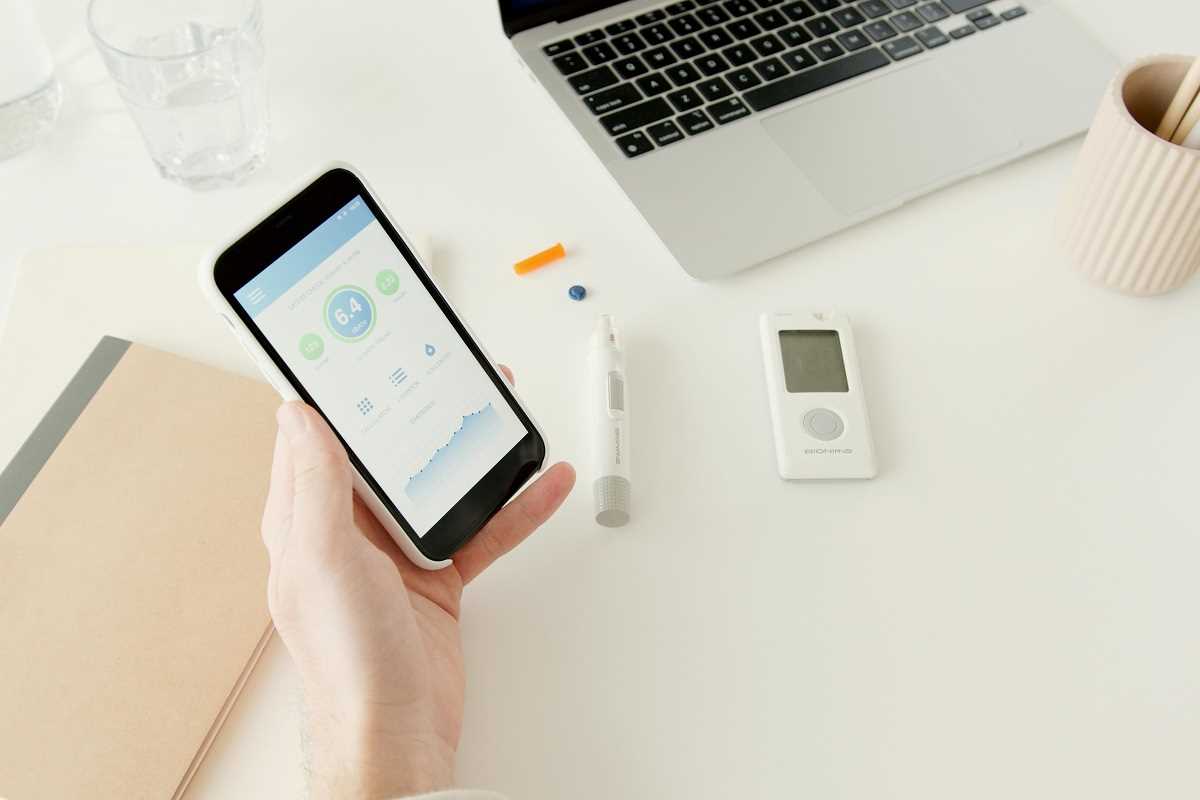Managing diabetes effectively requires consistent blood glucose monitoring. Thanks to advancements in technology, mobile diabetes monitors now make tracking glucose levels easier, more accurate, and more convenient than ever before. Devices like the Dexcom G6, FreeStyle Libre, and Accu-Chek Guide, paired with compatible mobile apps, have transformed diabetes management by providing real-time glucose data, trend analysis, and customizable alerts. These tools empower individuals to make informed decisions, improving both daily life and long-term health outcomes.
What are Mobile Diabetes Monitors?
Mobile diabetes monitors are devices designed to track blood glucose levels and seamlessly integrate with smartphones and other tech devices. They utilize advanced technology to offer precise glucose readings, often paired with apps for additional insights. Unlike traditional methods of blood glucose monitoring, these devices provide real-time data and trends, helping users better understand the factors that impact their glucose control.
There are two primary types of mobile diabetes monitors:
- Continuous Glucose Monitors (CGMs): These devices continuously measure glucose levels through a sensor worn on the skin.
- Smart Glucometers: These are enhanced versions of traditional blood glucose meters that synchronize with apps for data management and sharing.
Popular Mobile Diabetes Monitors and Their Apps
Below, we'll take a deeper look at some of the top mobile diabetes monitoring devices available today and the apps that complement their features.
1. Dexcom G6
The Dexcom G6 CGM system is one of the most advanced devices for monitoring glucose levels in real-time.
Key Features:
- Continuous monitoring through a small sensor placed on the abdomen or upper arm.
- Requires no fingerstick calibration, making it less invasive compared to earlier CGMs.
- Offers a 10-day wear period for each sensor.
- Transmitter sends data every five minutes to a connected smartphone, watch, or dedicated receiver.
Mobile App:
The Dexcom G6 App is the primary tool for accessing data from this CGM system. It provides:
- Real-time glucose readings.
- Trends displayed in user-friendly graphs.
- Customizable high and low alerts to prevent hypo- or hyperglycemia.
- Remote sharing features, allowing up to ten people to monitor the user's glucose levels.
The Dexcom Clarity app further offers in-depth analytics and reports that help individuals and healthcare professionals manage diabetes over time.
2. FreeStyle Libre
The FreeStyle Libre system by Abbott has gained widespread popularity thanks to its innovative sensor technology and convenience. The FreeStyle Libre 2 provides continuous glucose monitoring and has revolutionized diabetes care by eliminating the need for routine fingersticks.
Key Features:
- A small sensor is worn on the back of the upper arm.
- Offers 14 days of continuous monitoring per sensor, requiring only periodic scans for glucose readings.
- Affordable compared to other CGM systems.
Mobile App:
The FreeStyle LibreLink App is designed to work seamlessly with the FreeStyle Libre sensor. Key features include:
- Real-time glucose data when a smartphone is scanned over the sensor.
- Trends and patterns, which highlight how glucose levels respond to diet and activity.
- Optional alarm triggers for glucose highs or lows with the FreeStyle Libre 2 model.
For those who want to share their glucose data, the LibreView website and LibreLinkUp app allow caregivers and healthcare professionals to remotely access the patient’s readings.
3. Accu-Chek Guide
The Accu-Chek Guide is an advanced smart glucometer from Roche Diabetes Care, designed for those who prefer fingertip testing but want seamless data integration.
Key Features:
- Compact, portable design with a strip-loading system that minimizes waste.
- Accurate fingerstick results in seconds.
- Blood glucose readings that sync to smartphones via Bluetooth.
Mobile App:
The mySugr App connects to the Accu-Chek Guide for better diabetes management. Features include:
- Automatic syncing of glucose readings.
- Digital logging of food, insulin, and activity to provide a complete health snapshot.
- Custom reminders for testing and medication.
- HbA1c estimation based on logged data, offering insights into long-term glucose control.
Users can also share data with their healthcare providers using the Accu-Chek Connect Online platform, simplifying office visits.
Real-Time Data and Connectivity
One of the biggest advantages of mobile diabetes monitors is their ability to provide real-time glucose data. These devices use wireless technologies like Bluetooth or NFC (Near Field Communication) to transmit readings directly to apps. The apps act as hubs for monitoring glucose trends and understanding how lifestyle choices impact sugar levels.
With customizable alerts, users can get instant notifications if their glucose levels fall outside the target range. For instance, the Dexcom G6 alerts users to low glucose levels even during sleep, helping them avoid potentially dangerous situations.
Apps also make it easier for users to share data with others, including caregivers or healthcare providers. This constant flow of information helps in adjusting treatment plans and provides peace of mind for everyone involved in diabetes care.
How Mobile Diabetes Monitors Improve Diabetes Management
Mobile diabetes monitors significantly improve the way people manage diabetes through their features and benefits.
1. Increased Awareness
By offering real-time and continuous glucose tracking, these devices help users stay on top of their glucose patterns. This awareness encourages better decision-making, particularly concerning food, exercise, and medication.
2. Reduced A1C Levels
Studies have shown that devices like CGMs can lower hemoglobin A1C levels by helping individuals maintain tighter glucose control. Over time, improved A1C levels reduce the risk of diabetes-related complications such as kidney disease, neuropathy, and cardiovascular problems.
3. Convenience
Both CGMs and smart glucometers eliminate the hassle of manually logging glucose data. Automatically synced information ensures that users, along with their healthcare providers, always have an up-to-date picture of their health.
4. Safety
Customizable alerts for high or low readings can prevent emergencies. For example, FreeStyle Libre 2’s optional alarms warn users when their glucose levels are trending dangerously high or low.
5. Lifestyle Insights
Apps paired with these monitors allow users to log meals, workouts, and medications. The analytics then offer recommendations or trends on how lifestyle factors influence glucose levels. This makes it easier to build healthier habits.
The Future of Diabetes Management
The integration of mobile diabetes monitors with artificial intelligence and cloud computing is shaping the future of diabetes care. Features like predictive analytics, where apps detect patterns to warn about future glucose swings, are becoming more common. This next level of technology promises to help users even further in optimizing their treatment plans and avoiding complications.
Additionally, partnerships between device manufacturers and tech giants are paving the way for enhanced monitoring. For example, Apple Health and Google Fit are increasingly compatible with diabetes monitoring apps, ensuring a seamless user experience.
Mobile diabetes monitors like the Dexcom G6, FreeStyle Libre, and Accu-Chek Guide have revolutionized the way people manage diabetes. By providing accurate glucose data at a glance, these devices simplify daily routines and empower users for better control. The corresponding apps not only make monitoring more convenient but also offer insights that drive healthier choices and better outcomes.
 (Image via
(Image via


.jpg)


